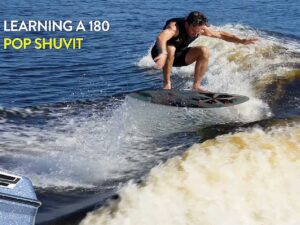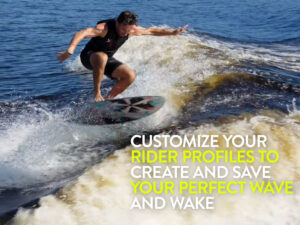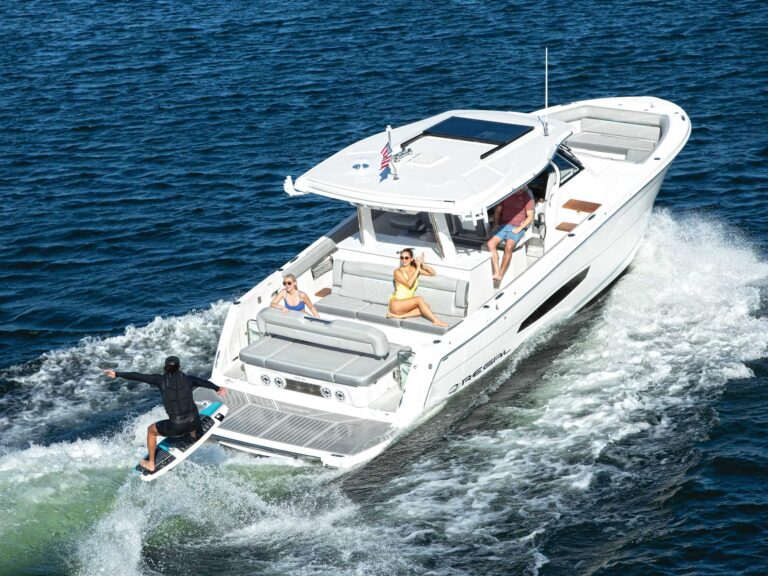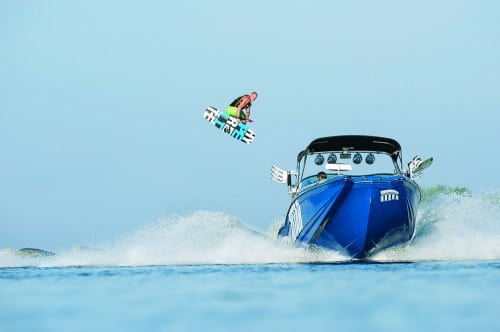
Wakeboarding can be a lot of different things to a lot of different people. To some, wakeboarding is heading to the cable park, and to others it is enjoying glassy days on the river. To Rusty Malinoski, wakeboarding is more about double-ups than it is for anyone else in the world. Much like everything worth achieving, double-up proficiency takes hard work, repetition, commitment and some guts. Lucky for you we tracked down a rider who is brimming with all of those attributes to tell us how he attacks this skill.
A quick conservative estimate of just how many double-ups Rusty has hit in his life leads to an astonishing number. We guessed that he hits about three double-ups per set that he takes. Some sets he might not hit one, but he has been known to take double-up-only sets, with 20 to 30 cracked off within a 45-minute session. Although he can handle four or five sets per day when in season, we settled on 400 sets per year to account for travel days and the rare downtime. Again, that is a conservative estimate. Being that Rusty has been on this tear for eight years straight since his move to Florida, that number totals to just shy of 10,000 double-ups. Let that soak in for a second, then read on to see how the double-up master himself approaches one of wakeboarding’s most exciting challenges.
The Setup and Timing
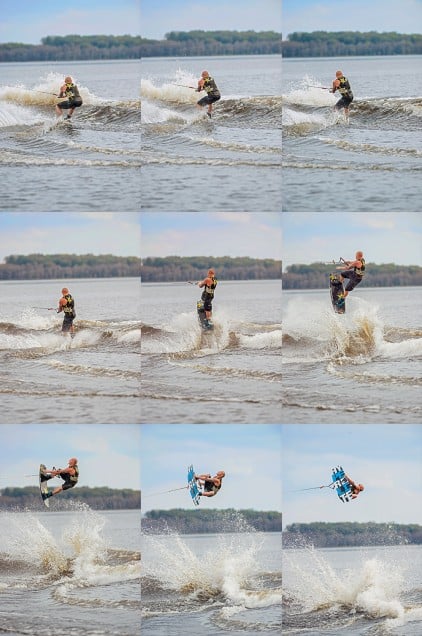
When asked what his favorite thing is about hitting double-ups, among Rusty’s answers was: “the timing and the challenge, because you don’t get the exact same double-up every time.” If Rusty Malinoski prepares for the variety in double-ups driven by the world’s best drivers, it is a good idea for you at home to prepare the same way.
A consistent setup is always a good foundation. If your starting points are in the right spot, you are much more likely to connect. Rusty likes to “stay close to the wake as the boat comes out of the final turn and aims for the rollers. Then edge out and drift just like you would for a wake trick.”
While this sounds simple, the rhythm of the setup for a wake trick is much smoother when the rider avoids hanging out on the outside for too long. With a double-up, it is equally important to swing out early enough to be ready to cut in, but not so early that the pendulum action of the arc is sacrificed.
“I like to drift in by coasting and rolling over the first and second rollers. Then I get on the edge to get into the third roller like a rhythm section in motocross. Get on the gas when you are on the downside and stay light over the peaks.”
Find the Zone
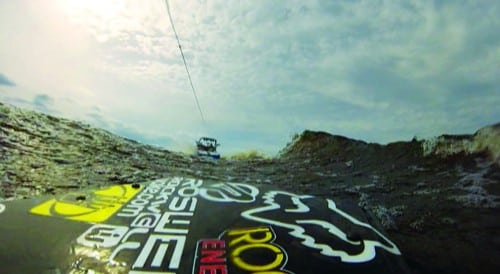
Rusty refers to this 8-inch zone that he aims for at the highest peak of the perfect double-up. Here we are seeing it from his board’s view. He reminds us that “As you are setting up and cutting in, the zone hasn’t formed up yet. You only see it at the end, so if you are too late or too early to line it up correctly, you won’t hit it. Anticipate.” Find this spot and get prepare for the kick.
Trickery
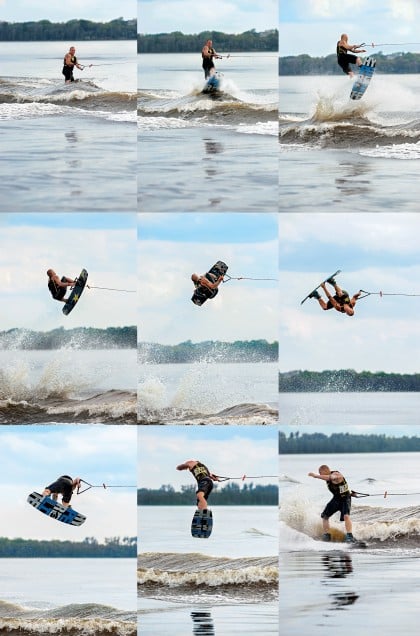
In Rusty’s early days of riding back home in Canada, he was immediately drawn to the double-up: “We had a MasterCraft Prostar 190, and the first time we figured out double-ups we were freaking out.” Obviously a far cry from what he attacks today behind his 2013 X-Star, but in his beginning stages of learning he utilized the extra time in the air to add rotations and continue to fill his bag of tricks. As a professional he finds that “It is hard to beat a photo of a really big double-up trick. You get to appreciate just how high people are going. The tower is probably 12 feet off the water, so when you see the rope angle going up to the rider, you know they connected.”
Here Rusty is floating out an indy tantrum to blind, a trick that he easily does off the wake. The differences he points out are that “I roll in a little slower than for a wake-to-wake to get more of a straight up-and-down pop. You have to check your speed so you don’t overshoot the landing.”
The line tension is certainly a part of double-up tricks that needs to be managed. With so many changing variables it is difficult to predict the tension you will feel, but as a general rule there is a sharp increase in tension that coincides with the amount of kick that you feel from the double-up. The more you connect, the more tension you will feel just off the top. With a trick like this one, Rusty says, “I am ready for the tension and try to keep some all the way through so I can use the tension to do the backside 180 at the end.”
By comparison, a trick like a heelside frontside 7 requires a different takeoff. “Pull yourself into the boat to help with the handle pass,” Rusty stresses. In doing this he is using that spike in tension felt at the launching point to his advantage by initiating the spin while advancing himself toward the boat, to have a looser line to spin with at the peak.
Setting It Down
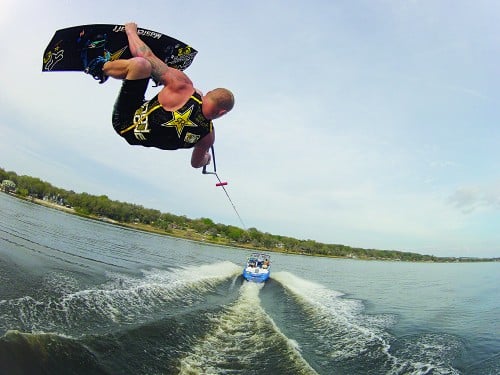
Timing a double-up is just one part of the equation. Putting the landing gear down to stomp your tricks is the other part. Fortunately a well-timed, solid takeoff leads to finding the cushiony soft ideal landing spot. With the extra hang time patience is key so as to not overrotate your tricks. Here Rusty is doing a heelside indy roll to blind with time to really spot his landing while he is still at the peak. From here, he will initiate the backside 180 after waiting longer than he would if he had just gone off the wake.
Rusty says, “Landing right on the downside of the second wake is the best feeling. There is almost no impact. Coming up short and casing the second wake or overshooting and landing in the trough are when it can hurt. The more double-ups you hit, the more you will feel it out.”
Team Effort
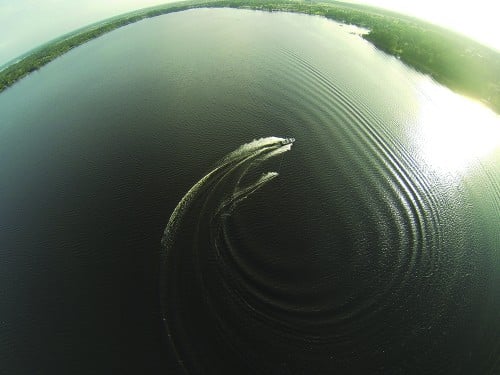
The driving of a proper double-up is an acquired skill as well. Having an understanding of how your actions make the double-up form is vital to becoming a Rusty-approved driver. Just as with hitting them, the more double-ups you drive, the more feedback you will get from the riders and the better you will become.
In the search for a perfect double-up, Rusty says, “I think it is super important to pre-turn and drive straight for long enough to properly set the zone where you are going to end up hitting the double-up.” If the boat is not going straight after the pre-turn, the rollers may either be knocked down in size or be hard to get into.
As a general rule, Rusty finds that “Keeping the angle of the boat open through the double-up makes it easier to get into, but I usually like my double-ups T’ed up at 90 degrees. For some tricks I even like it over-T’ed, but they are difficult to get into.”
“My X-Star has Zero-Off , so I know that as long as the driver allows enough space to make the double-up, the speed will be dialed. Before Zero-Off, speed was yet another thing to think about. Not anymore.”

